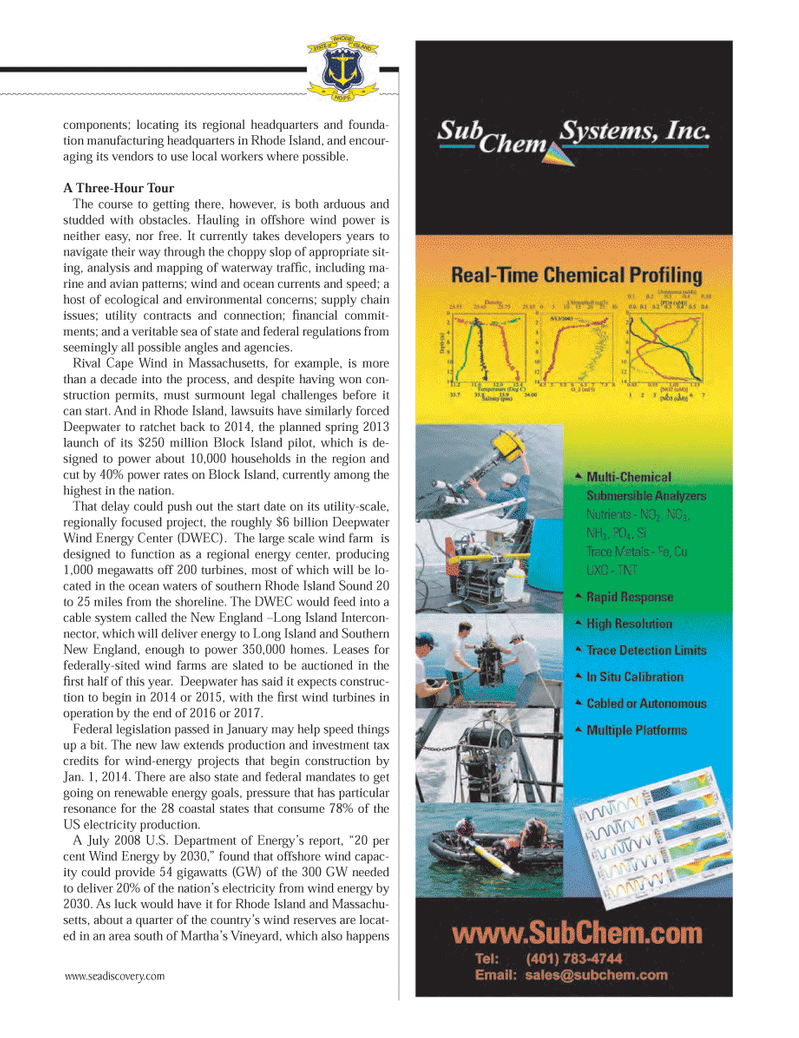
Page 45: of Marine Technology Magazine (March 2013)
Instrumentation: Measurement, Processing & Analysis
Read this page in Pdf, Flash or Html5 edition of March 2013 Marine Technology Magazine
components; locating its regional headquarters and founda- tion manufacturing headquarters in Rhode Island, and encour- aging its vendors to use local workers where possible. A Three-Hour Tour The course to getting there, however, is both arduous and studded with obstacles. Hauling in offshore wind power is neither easy, nor free. It currently takes developers years to navigate their way through the choppy slop of appropriate sit- ing, analysis and mapping of waterway trafÞ c, including ma-rine and avian patterns; wind and ocean currents and speed; a host of ecological and environmental concerns; supply chain issues; utility contracts and connection; Þ nancial commit- ments; and a veritable sea of state and federal regulations from seemingly all possible angles and agencies. Rival Cape Wind in Massachusetts, for example, is more than a decade into the process, and despite having won con- struction permits, must surmount legal challenges before it can start. And in Rhode Island, lawsuits have similarly forced Deepwater to ratchet back to 2014, the planned spring 2013 launch of its $250 million Block Island pilot, which is de-signed to power about 10,000 households in the region and cut by 40% power rates on Block Island, currently among the highest in the nation.That delay could push out the start date on its utility-scale, regionally focused project, the roughly $6 billion Deepwater Wind Energy Center (DWEC). The large scale wind farm is designed to function as a regional energy center, producing 1,000 megawatts off 200 turbines, most of which will be lo- cated in the ocean waters of southern Rhode Island Sound 20 to 25 miles from the shoreline. The DWEC would feed into a cable system called the New England ÐLong Island Intercon- nector, which will deliver energy to Long Island and Southern New England, enough to power 350,000 homes. Leases for federally-sited wind farms are slated to be auctioned in the Þ rst half of this year. Deepwater has said it expects construc- tion to begin in 2014 or 2015, with the Þ rst wind turbines in operation by the end of 2016 or 2017.Federal legislation passed in January may help speed things up a bit. The new law extends production and investment tax credits for wind-energy projects that begin construction by Jan. 1, 2014. There are also state and federal mandates to get going on renewable energy goals, pressure that has particular resonance for the 28 coastal states that consume 78% of the US electricity production. A July 2008 U.S. Department of EnergyÕs report, Ò20 per cent Wind Energy by 2030,Ó found that offshore wind capac- ity could provide 54 gigawatts (GW) of the 300 GW needed to deliver 20% of the nationÕs electricity from wind energy by 2030. As luck would have it for Rhode Island and Massachu- setts, about a quarter of the countryÕs wind reserves are locat- ed in an area south of MarthaÕs Vineyard, which also happens www.seadiscovery.com MTR #2 (34-49).indd 45MTR #2 (34-49).indd 453/6/2013 1:22:43 PM3/6/2013 1:22:43 PM

 44
44

 46
46
